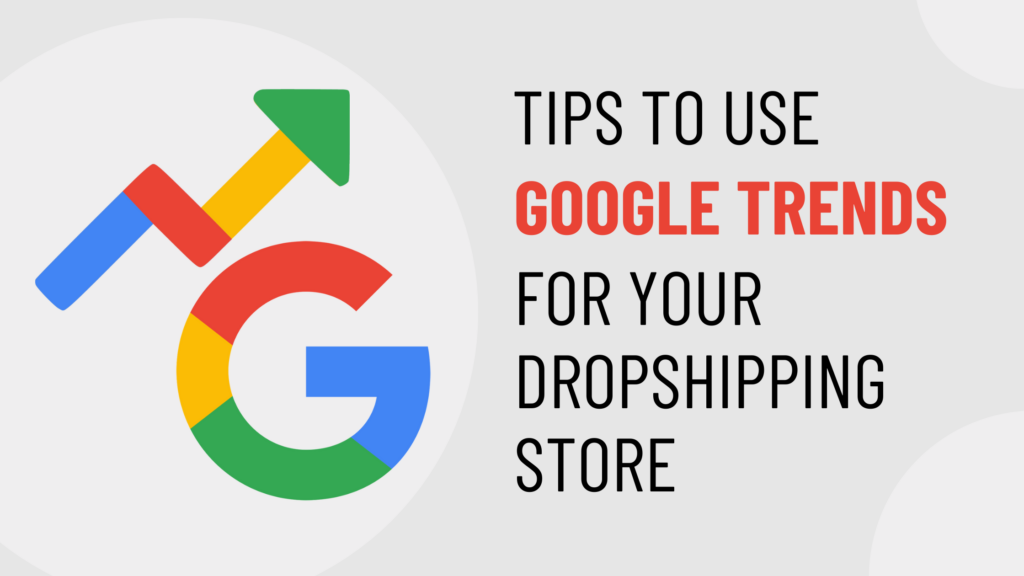How to use Dropship to Reach More Customers Online
It’s no secret, physical retail has been on the decline, and the traditional retail customer is doing more of their shopping online. In a world where more consumers are shopping online, bound by only a browser tab and a back button, digital marketing for retailers has become increasingly important, and so has the need to get creative to find new ways to compete online.
This is where Dropshipping comes in.
Dropshipping allows you to advertise and fulfill products that do not require any upfront investment or overstocking risk. Therefore you can gain exposure from a wider audience of online shoppers, at a minimal cost.
When some think of dropship, they may think of slim margins and a heavy reliance on your supplier to provide a quality product and timely shipping.
However, you can imagine how this flexible, low-risk model allows you to be more creative and strategic in your marketing efforts, without investing in the product and storage costs typically required when buying wholesale.
If you are seeking new ways to reach more customers online, leveraging dropship to increase your reach and awareness is a strategy worth evaluating.
The Importance of Being “Found” Online
The idea of adding dropship products to your catalog to increase sales is not about adding more products to sell and profit from. It is about increasing the chances of your product and company brand “being found” when a new or even existing customer is shopping online.
When your customer is in need of a product that you may be able to provide, you can not depend on them to think of you first. You must be thinking about them before they even know they need your product, and be ready to fulfill their request when this time comes.
Unlike the more loyal brick and mortar consumer, bound by geographical convenience, online shoppers are fickle and wavering. Sure they have brand loyalty, but they also have search engines, price comparison tools, and a selection of inventory no physical marketplace could ever offer.
Online shoppers have come to expect retailers to bring the products to them and not the other way around.
That’s why even the mighty Amazon invests heavily in getting in front of their customers. Amazon knows that even though 51% of consumers searching for products start with Amazon as their search engine, the online consumer has choices, and being the first choice takes more than building a brand.
It’s the reason why Amazon is Google’s largest Adwords customer, spending 157 million in 2023 slightly less than the year 2022 which was 20.6 billion. This marketing strategy helps Amazon ensure that when you are shopping online, you will find them — even if you are not “thinking Amazon”.
The idea that Amazon.com owns the largest share of online shopping searches, but is also the highest spending customer of Adwords (from their biggest competitor), really shows how important “getting found” can be in the competitive online retail world.
It seems Amazon believes that no matter how much market share you have or how strong your brand name is you can’t rely on your customers to come to you; you must invest in strategies to get in front of them.
Walmart and Sears might also agree… — coming in at #7 and #8 in Adwords spend.
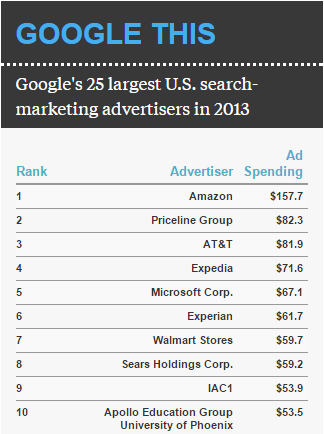
Creative & Cost Effective Marketing with Dropship
Obviously, we people don’t have the budget or the brand that Amazon, Walmart, or Sears have. So we need to get creative to compete.
As a retailer, you know how to merchandise, and I’m sure you have made strides in SEO, paid advertising, and social media. However, when it comes to “bottom of the funnel” product marketing, there is only so much advertising budget you can put into a single product to see a positive return on investment. Likewise, trying to market and compete online with your best selling products might not always be the most profitable approach.
Instead, you can leverage dropship for creative and cost effective marketing.
When employing a dropship strategy, you have the ability to list more products online with no upfront financial investment. Ideally, listing these products will pique the interest of someone in your target audience who might not have found (or remembered) you otherwise.
If the products you decide to offer on a dropship basis are selected strategically, gaining exposure to these products can be less of an investment in time and money than what would usually be required from your core products.
Let’s look at an example of how this is done.
Say you are a tactical & survival gear retailer and your best selling product is the “5.11 Rush 12 Backpack”.
This is a pretty popular item, so competition is high.
If we were to do a quick Google Search for this product you would see that not only are you competing with the big brand advertising budgets, but you are also fighting an uphill battle against their domain strength in the organic search results.
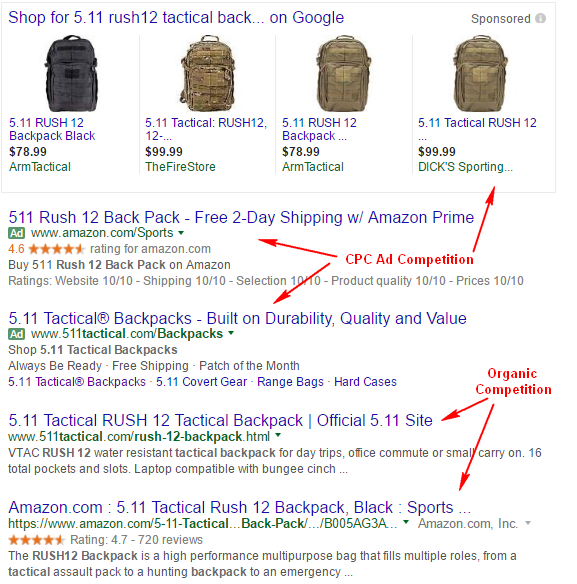
Another thing you might notice if you were to scroll down the page is that the popularity of the product has filled the SERP with images and YouTube videos.
It looks all about impossible to compete on this product’s SERP.
It’s unfortunate because you know that if someone is searching for this product they are likely a target customer, and you won’t get the opportunity to get their attention, at least not in a smart and profitable way.
However, it is probably safe to assume this same customer is researching similar products as well. As a savvy retailer, you may have a good idea of what these products might be. However, it is always good to leverage other resources where we can.
And who better to leverage?
Your biggest competitor, Amazon.
Researching Potential Dropship Products on Amazon
If I head to Amazon and search “5.11 Rush 12 tactical backpack”, I get a few other backpack brands that Amazon has deemed relevant to my search intent and would likely also want to purchase.
Given the large data set and focus on suggested product algorithms, I am going to treat these results as a fairly good assumption of products I might want to advertise for and gain the attention of my target customer.
If I dive in even deeper and head to the actual product page of the 5.11 backpack, Amazon presents me with other products in the following sections:
- “Frequently bought together”
- “Customers who bought this item also bought”
- “Sponsored products related to this item”
This is basically a treasure chest of potentially less competitive product ideas to advertise for on search engines and gain awareness from this same target customer that I could not compete for on the 5.11 backpack.
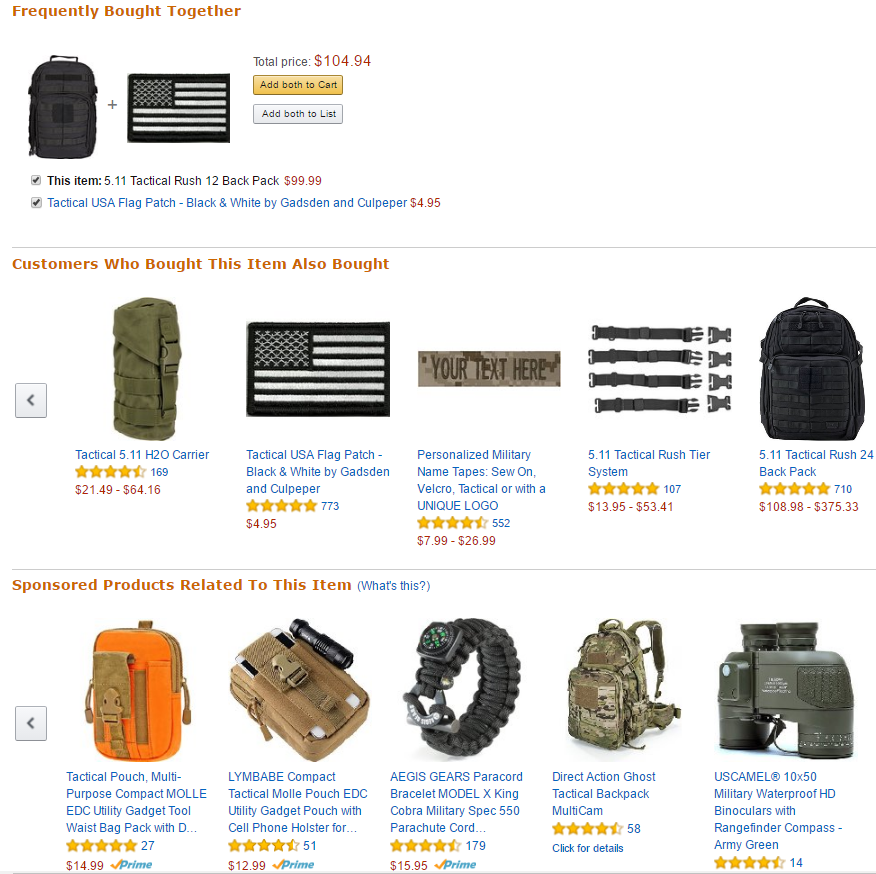
Image (Amazon.com)
Once you’ve identified a few potential items that you might want to sell and advertise for, you will first want to get a quick feel for how they stack up in sales rank on Amazon.
Viewing the sales rank is more of a thumb in the air approach here to just gauge the demand for the product against others. I wouldn’t put too much time into analyzing rankings here.
Once you’ve vetted there is a workable amount of demand for the product (sales rank under 500 in its specific category), you are ready to start doing search engine marketing competitive research.
Side note: You will also want to identify any products that you feel your current suppliers might carry, just to keep things easy. If you need to find a dropship supplier for an item, that is another step and another article, but there are a ton of dropship supplier directories and resources out there to find dropship suppliers in your industry.
Search Engine Marketing Competitive Research
When looking for products to dropship you are searching for those that:
- Are highly correlated or complementary to the wholesale products you carry
- Have demand and are going to be frequently searched online
- Allow you to compete cost-effectively on Search Engines (Paid & Organic)
We take care of #1 and #2 using Amazon suggested products and sales rank, but we still need to see if we have a better chance of competing for this product on the Search Engine Result Pages (SERPs).
I personally like to use a combination of Moz.com and SEMrush.com to analyze the SERP and Adwords competition. However, when you are searching for “long tail” exact product names, heading to the SERP and “eyeballing it” can be pretty valuable as well. Similar to analyzing the sales rank, use a mix of data and your gut. But most importantly, avoid analysis paralysis.
With that in mind, let’s look at two different dropship product selection strategies you can take after following the process we just outlined.
Strategy 1: Find a Similar, Less Competitive Product
We saw that when we searched for our 5.11 Rush 12 backpack one of the suggested products in the search results was a “Direct Action Dragon Egg Tactical Backpack”.
Doing a quick sales rank comparison in the relevant category, it seems this Direct Action backpack has a decent sales rank and there is some demand there.
When searching Google for the product name, we get this.
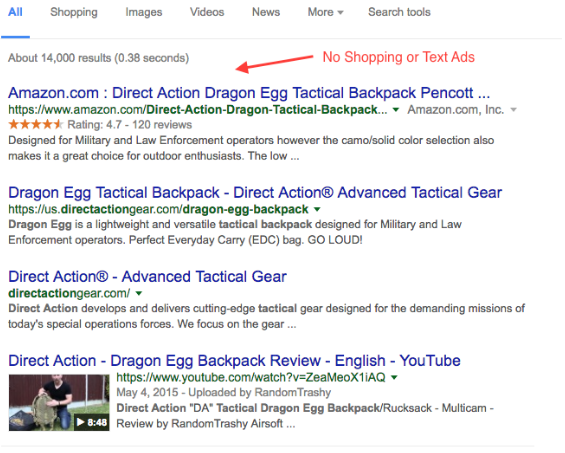
The first thing I notice is that it appears there is zero competition for Ads, which can mean two things:
- Google doesn’t offer ads for this keyword
- No one is currently bidding for the keyword in text or shopping ads
In either scenario, there is less competition for SERP space. If Google doesn’t offer ads this means that high-priced ads are not stealing organic clicks for which you may be able to rank. In the case that no one is simply bidding for them, you know you will likely be able to dominate the first position with either a text or shopping ad at minimal cost or competition.
The second thing I noticed is that Amazon and the brand “Direct Action” do rank #1 and #2, which is going to be pretty common for anything that has a sales rank under 500.
However, there are not multiple listings from Amazon or other big name brands dominating the top 5 results. If you were to scroll down, you also see several smaller retailers ranking in the 6-10 positions, which you might have a shot at outranking them for their spot. For a deeper analysis of how tough the other websites listed might be to “outrank”, you can look into the “domain authority” using Moz.
The Takeaway?
This backpack is not as popular therefore it is not as competitive. However, given it is one of the first suggested results on Amazon and it has a respectable sales rank, we can assume it has a similar customer type frequently searching for it online.
After doing our SERP analysis, it also appears it would be less expensive and time-consuming to be able to gain some traction on the first page of Google. Sure your margins on this backpack might be slimmer, and the demand might be lower, but selling the backpack is not the idea.
The idea is to strategically acquire a website visitor in your target market at a low cost of acquisition that you can now nurture, upsell, and cross-sell your wholesale products.
Selling the backpack is a bonus.
Strategy #2: Find a Cheap Complementary Product
These days, it is expensive to advertise on Google.
Google Shopping Ads (aka Product Listing Ads or PLAs), typically have a less expensive cost per click (for now) and allow you to advertise individual products with images, prices, and more in SERPs to customers looking for a specific product.
These content-rich ads are a great way to get in front of your target customer with much more qualified (and often cheaper) clicks.
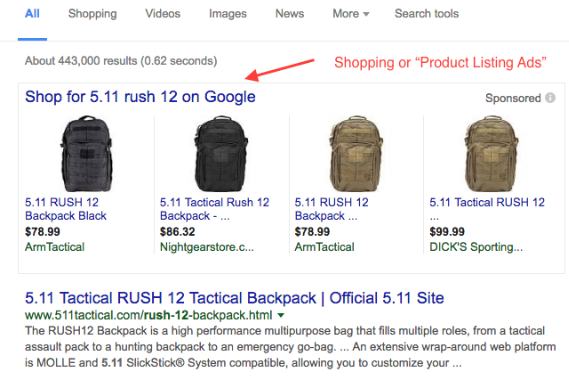
However one of the key differences in Product Listing Ads vs. the traditional text ad is you actually need the product in stock on your website to be able to list these product ads.
Once again, dropship to the rescue.
As retailers know, it is not feasible to buy, stock, and sell every product their target customer might be searching for online. Dropship provides a huge opportunity to be able to advertise (and sell) many more products online in these PLA ads to your potential customers.
When adding dropship as a retail marketing strategy, you can claim more of these product listing ad spaces. Now you can advertise for items that you might not purchase wholesale, but your customers and potential customers are actively searching for online.
But Google gets expensive. So retailers need to be strategic.
It is typical for a higher-priced item to carry a higher cost per click.
Given that, let’s look at a way to keep our cost of customer acquisition down with our 5.11 Backpack example.
On the Amazon listing for the 5.11 Backpack, it has under the “Frequently Bought Together” section a “Tactical USA Flag Patch”.
This is a perfect example of a product that is
- Low cost (low CPC)
- Low weight (low shipping expense)
- Complementary to a core wholesale product or product line
A low-cost, low-weight product that directly complements your core product or ideally a core product line might not be a profitable product to stock, pack, and ship, but it can serve as a highly targeted lead generation tool for your business.
Doing a quick search on Google for “Tactical USA Flag Patch”, you will find list prices as low as $1.99 and would likely have a very low CPC required bid to be able to rank. PLAs are a little different than traditional text ads where you can’t simply “buy” your placement, but your max CPC bid has a lot to do with your placement.
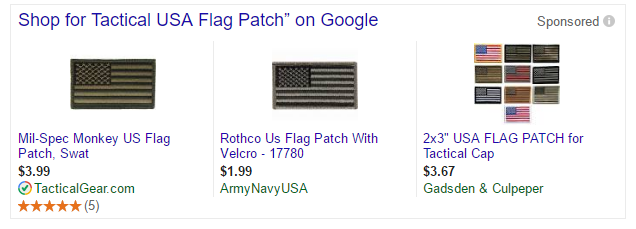
Quick Tip: Amazon might be the largest buyer of Google Ads, but they don’t bid on PLAs (likely because of their competing offering), so there is one less big fish in the pond.
You may be wondering ”How can I make any money dropshipping a $2 patch that I paid 30 cents on Google Shopping to sell?”
The answer is you don’t.
Some people call these products “tripwire products” because they allow you to easily “capture” or “convert” a new visitor into a customer with little friction (low cost / easy decision).
Once someone converts from a “visitor” to a “customer”, you have established trust with them and they now have a different perception of your brand. In addition to the warm and fuzzies, they have gone through the checkout process, you have collected more detailed information, and they are now expecting emails from your company.
Now, you are in a much better position to market and sell your high-margin products to this customer in the future, at a much lower acquisition cost.
Although you might break even or lose money on selling this product individually, you have to look at it as an investment in customer acquisition. With the right product selection and remarketing approach, you might not need to even sell one patch for the ad budget to still have a positive ROI.
Listing and advertising dropship products is a low-cost, low-risk strategy that allows you to cast a wider net for customers that your competitors might be overlooking.
And when fishing in a crowded sea, competing with bigger fish, and a wider net can be the difference between success and failure.

